3D, Holograms, Light Fields and Volumetric Displays
In this post I hope to give a good view on 3D technologies which offer to show a scene with depth.
Lets start with what 3D is.
When you look at a scene in front of you, whether it’s with one eye or two eyes, there a certain number of ‘cues’ which trigger your brain into seeing the scene with depth. That is to say not as you would a photograph on a sheet of paper.
The table below shows a number of cues for depth.
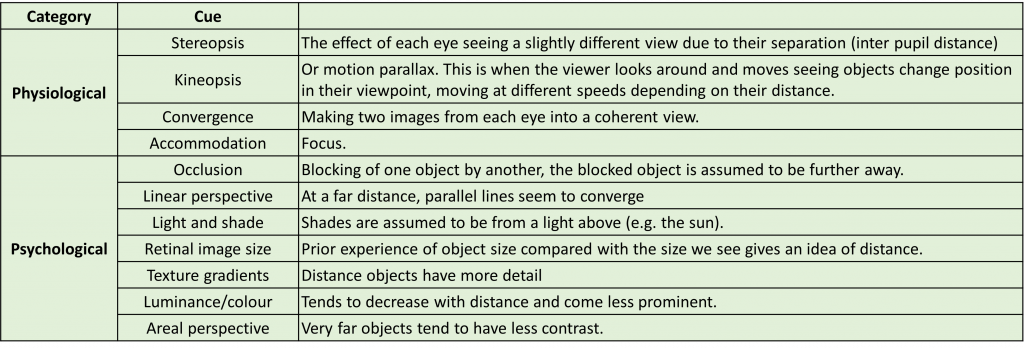
Maybe it’s thought that you need to have two eyes to see depth, but there are other cues which enable depth perception for a single eye, e.g. Occlusion, Linear perspective etc.
When you try to recreate a real 3D view, then you must attempt to satisfy all these cues.
In the following parts we’ll look at 3D on a 2D screen, holograms, light field displays and volumetric displays. It should be noted that these terms are often interchanges and definitions of each are not strictly adhered to.
.
3D image on a 2D display
Think 3D films at the cinema. The film is projected onto a 2D screen but we ‘see’ 3D. But here what we see is a depth component.
These systems work on the principal that the projected image actually contains two viewpoints of the filmed scene, each representing the view from each eye if we were actually in the scene.
In early films, each image of the scene as captured by two cameras, separated by a distance equal to the distance between our left and right eye (an average). passes through a filter, red and cyan.
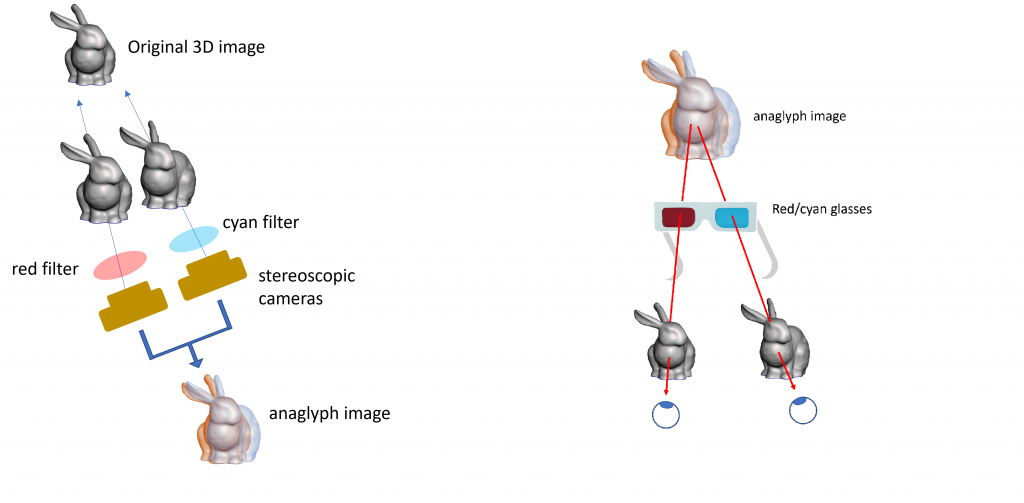
The images are combined into what is called an anaglyph image and recorded. When viewing, the trick is then to separate the screen images out so only one of the two goes into each eye. This is achieved through wearing special glasses.
More recently, other techniques have been used to separate out both images, including polarized lenses.
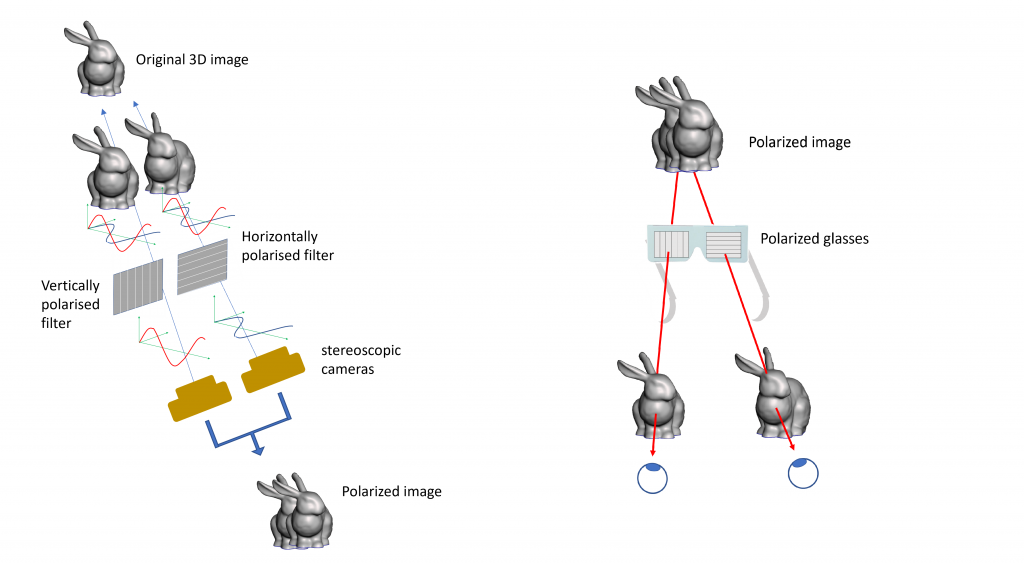
Light is a wave and has certain properties in including polarization.
Light is an electromagnetic wave consisting of oscillating electric and magnetic fields which are always perpendicular to each other. When polarizations are discussed it generally refers to the electric wave. Light has an equal mixture of polarizations but we can restrict to one by passing through a filter as in the diagram above.
An advantage over the red/cyan scheme is that the colour of the polarized 3D is unaffected.
This is not however true 3D. Take the cinema example. Everyone in the cinema will see the same scene with depth, those at the end of the rows at the sides will not see to the side of any object any more than those seated in the middle. For that we need light field or volumetric displays.
Another possibility is to generate an image on a 2D display, detect where the viewers eyes are, and adapt the displayed image according to the orientation. In this scheme only one person see the effect at any one time.
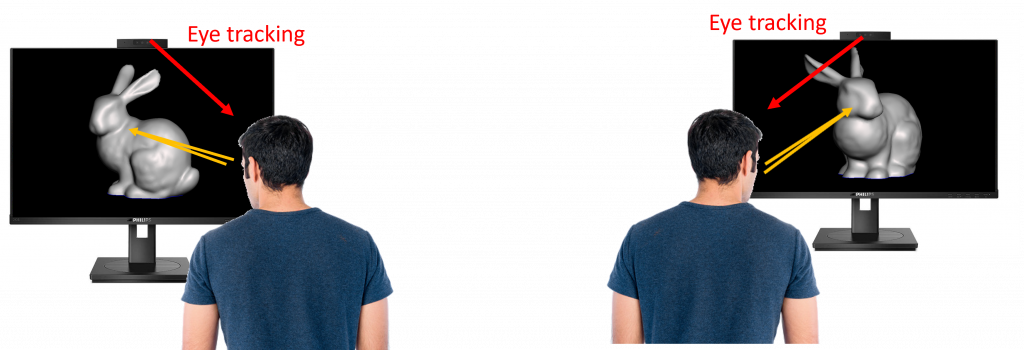
.
2D Image on a 2D Display
This may sound a curious addition to this article, but 2D images on a 2D display are often described as 3D by those selling such technologies.
A simple example is a Fan Clock. Here a rotating strip of LEDs on the fan blade illuminate in a certain way, synchronized to the rotating blade. If the LED flashes once every blade revolution, then is will look like a stationary point. Many LEDs on the blade then can cover a full circle and if illuminated correctly then can produce an image. So why is this declared 3D ? well it can actually look 3D. A more elaborate system uses a higher density of LEDs and not just one blade but up to 6 are used. (not necessarily a fan either). The reason you get some sort of 3D effect is that apart from the object you see through the display and see whatever is behind it, often at a further distance you that gives you a sense of depth. Secondly, these system often rotate the displayed object, so the viewer doesn’t move, the object does.

The other example in this category is Peppers Ghost. For more on this, see the details on the hologram project: https://darlotech.co.uk/?page_id=31
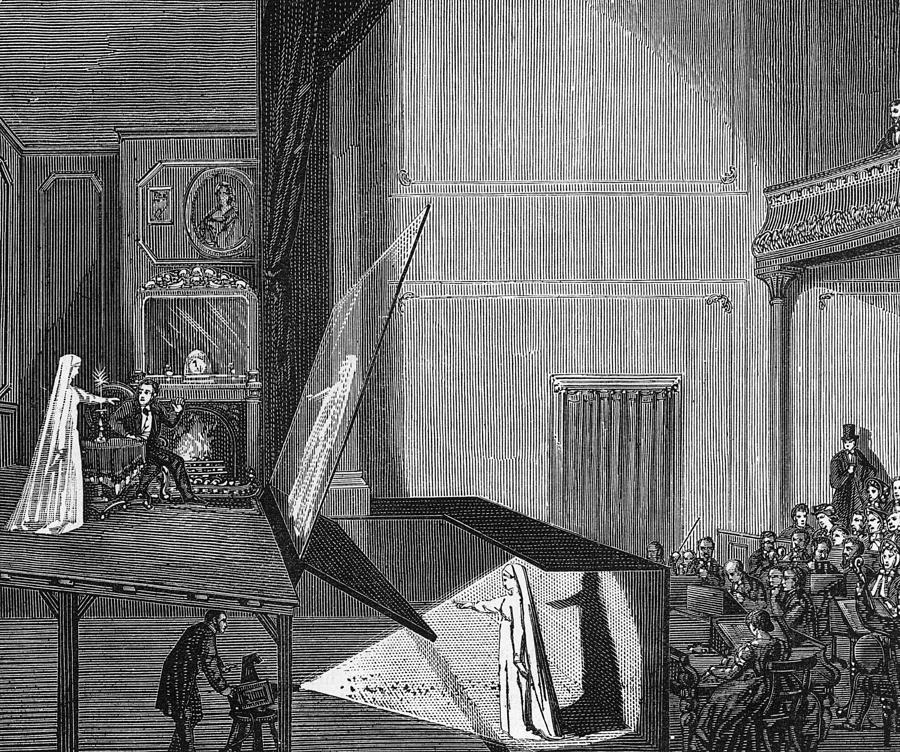
.
Holograms
Most would have heard of holograms, virtually everyone has one, on the back of their credit or bank card for security purposes.
So, how do holograms work? Holography is a unique method of photography whereby 3D objects are recorded using a laser and then restored as precisely as possible to match the originally recorded object.
We split our coherent laser beam into a reference beam and a beam which we shine onto the object. With a bit of mirroring, the two beams are made to meet on a holographic plate. When they meet, the waves create a new pattern which has within it, information on the 3D object.
Suppose the reference beam is Ref, the object beam is Obj, and the interference pattern is Int.
Then we can say:
Ref + Obj = Int
If we too the reference beam and shone it to the film from the back ? Then we would have:
Ref – Int = Obj
and so shining a laser beam in through the back of the film is how you get out the original object beam.
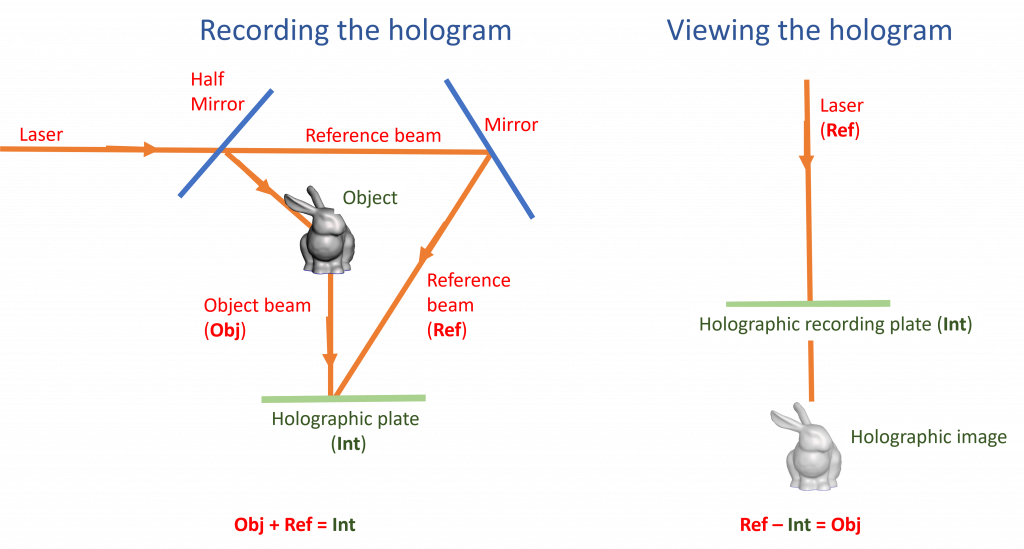
Several different materials can be used for the holographic plate which records the hologram. One of the most common is a film very similar to photographic film (silver halide photographic emulsion), but with a much higher concentration of light-reactive grains making it capable of the much higher resolution that holograms require. A layer of this recording medium (e.g., silver halide) is attached to a transparent substrate, commonly glass or plastic.
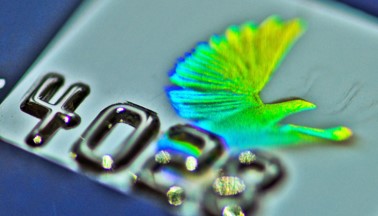
.
Light Field Displays
A light field is a collection of light rays in a particular area. To capture a light field means to capture the rays of light from a particular perspective — their color, intensity, and directionality — so that they can be recreated and viewed later. Light Field Displays are based on a dense “field” of light rays produced by either a high resolution LCD panel or a projector array.
They work by chopping up the image volume radially, a bit like a cake. Light Field Displays typically have an angular separation of around one degree between slices. The slices are ordered and recorded for displaying.
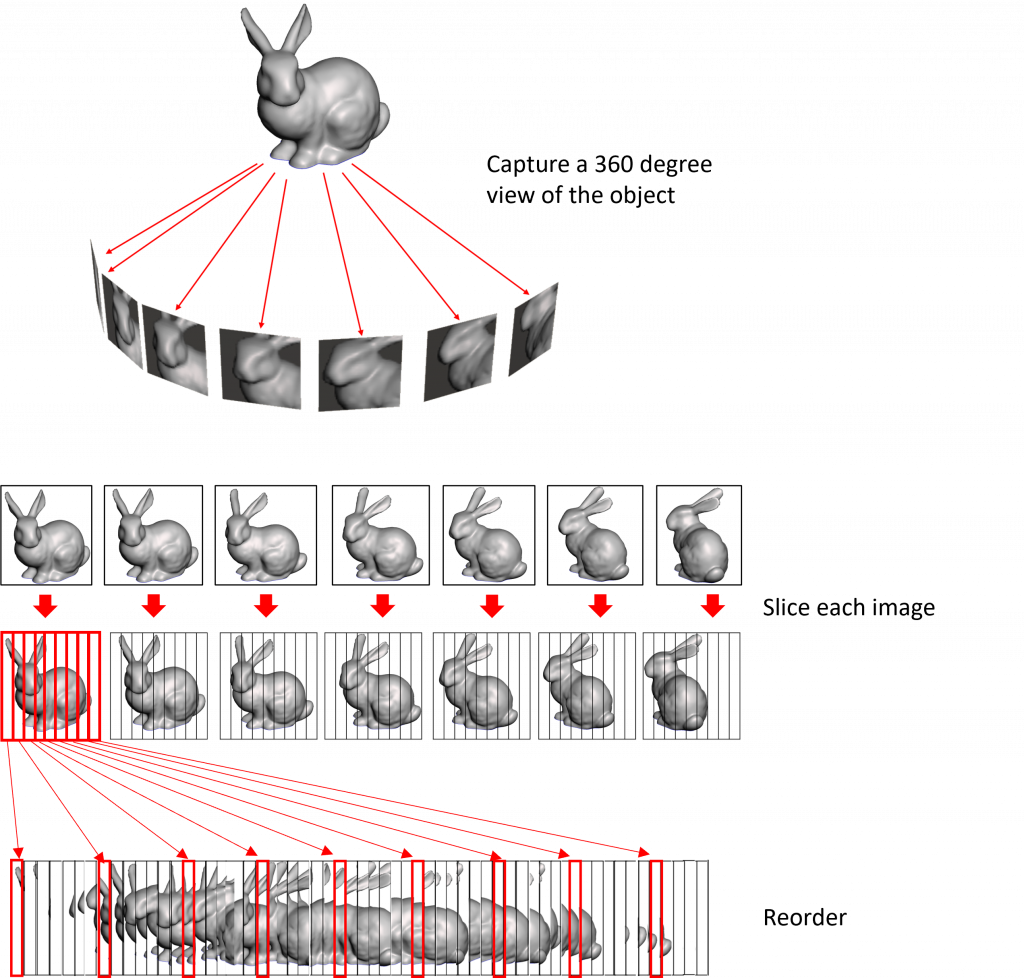
The display using a lenticular lens, will operate such that for any position of the viewer, the lens will direct the relevant slices for that viewpoint to the viewer. At normal viewing distances each pupil in your eye gets at least two slices. The result is that adjacent views blend seamless together as the viewer moves around the scene within the field of view (FoV) of the display (typically ~50 degrees or more).
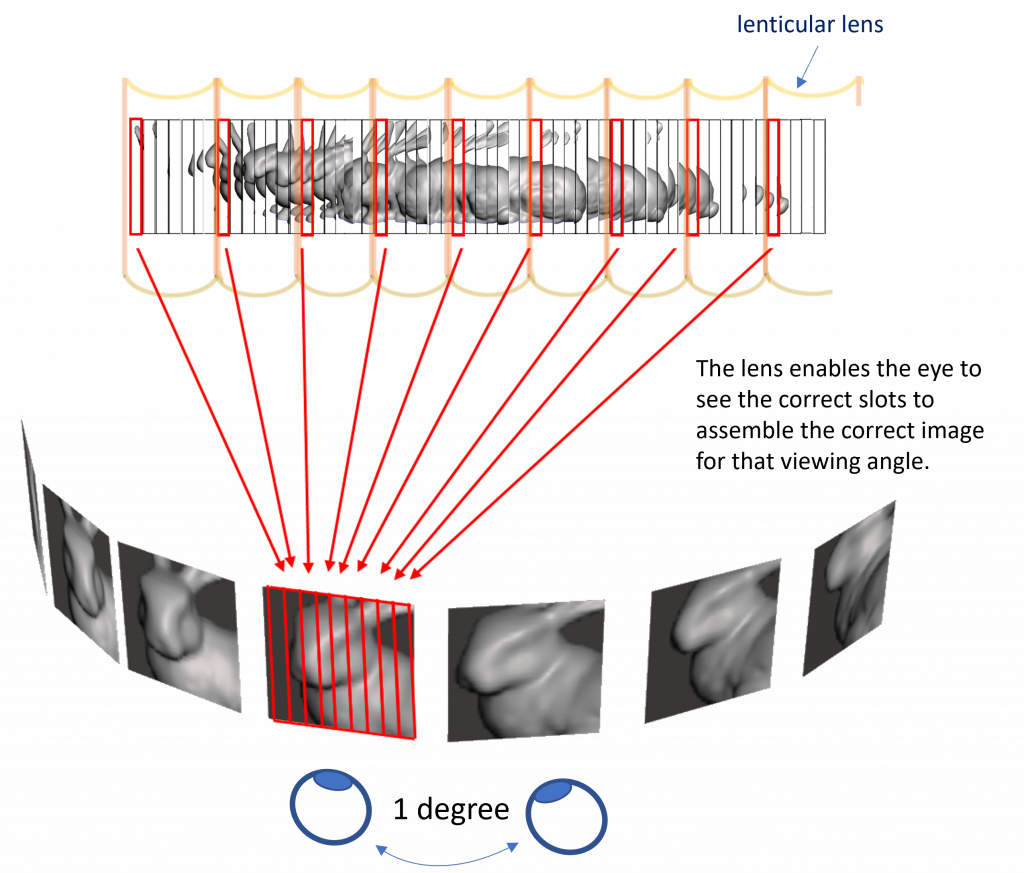
Volumetric Displays
In a volumetric display, the image to be displayed is divided into slices and the slices are then displayed to the viewer in very rapid succession so that the viewer perceives a persistent, continuous object. The image is typically sliced in one of two ways. One method is to project on a rotating heliod display. By selecting the timing and direction of each pixel projected onto the display, any pixel (now a voxel) can be positioned anywhere in a 3D volume.
I don’t get too hung up over definitions of Light Field Displays or Volumetric Displays as some use a combination of both and descriptions are not too detailed for confidentiality reasons.
